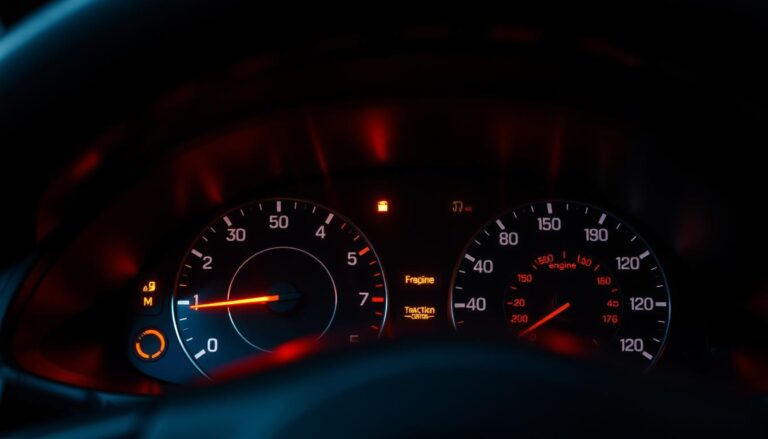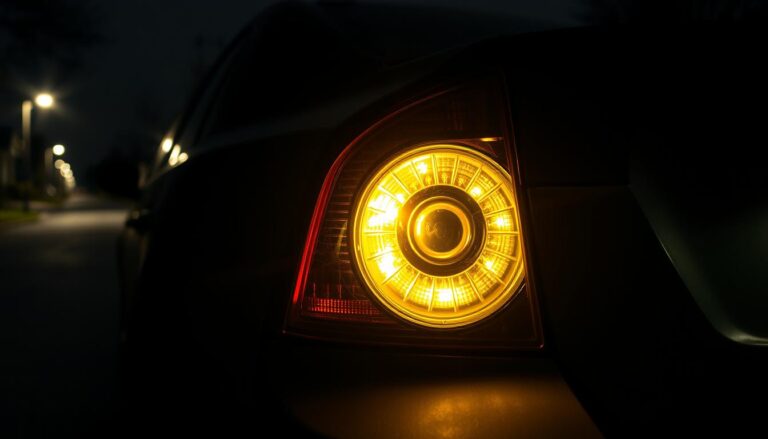If your car’s brake maintenance has slipped past the recommended interval, act now. A hydraulic medium links pedal force to the calipers. When that medium absorbs moisture or picks up contaminants, stopping power drops and emergency stops can become risky.
This short guide explains how the system works, why manufacturers set replacement intervals near every two years, and what happens when a year or more is missed. You’ll learn simple driveway checks, warning signs like a spongy pedal or longer stopping distances, and when to limit driving until the lines are refreshed.
Follow practical steps to protect performance and safety, preserve ABS components and calipers, and avoid costly repairs. Choosing the right place for inspection — an experienced shop with proper tools — restores a crisp pedal feel and reliable braking behavior.
Key Takeaways
- Old fluid reduces stopping power: moisture and contaminants degrade performance.
- Manufacturers recommend regular replacement, often about every two years.
- Watch for a soft pedal, leaks, or longer stopping distances as warning signs.
- Quick checks at home can flag problems before they escalate.
- Professional inspection restores safety margins and protects ABS and calipers.
Why an Overdue Volvo Brake Fluid Service Compromises Safety and Performance
A worn hydraulic medium quietly reduces stopping power long before a warning light appears. The braking system depends on liquid that transmits pedal force from the master cylinder to the calipers. Any loss of fluid or intrusion of air lowers pressure and weakens response.
How the hydraulic principle works
Pressing the pedal multiplies force through the master cylinder, sending pressurized oil through lines so pads clamp rotors. That simple transfer is the core of safe stopping.
Moisture, boiling point, and corrosion
Over time the liquid absorbs moisture, which lowers its boiling point. Vapor bubbles form under heat and cause fade, lengthening stopping distances when you need control most.
Real-world risks and component wear
Air or small leaks create a spongy pedal and extra travel. Corrosion attacks metal lines, calipers, and ABS components, causing seized parts and uneven braking.
- Practical risk: heavy traffic, steep grades, or towing can overheat old liquid and reveal problems.
- Note: miles and years both matter—age alone can degrade performance and stress adjacent parts like seals and suspension.
Volvo Brake Fluid Service Overdue: Why it Matters and What to Do
A few simple checks can reveal whether your stopping system needs attention. Start with obvious warning signs: an illuminated ABS lamp, a soft or sinking brake pedal, longer stopping distances, or a burning smell after heavy use.

Next, perform a safe visual check under the hood. Inspect the reservoir level and look at the fluid color. Clean to light yellow is normal; dark or cloudy oil shows contaminants and aging.
What to note and test
Write down the last service mileage and time. If it’s near two to three years or many miles since the last change, plan a flush even when driving feels OK.
- Feel the pedal during a careful stop; extra travel or inconsistent response can mean moisture or air in the lines.
- Transient fade after repeated stops is a red flag, not a quirk.
- Limit heavy braking until the system is refreshed to avoid overheating old oil and worsening issues.
“Document mileage and conditions — city traffic, hills, or towing — and share photos of the reservoir and any dashboard messages with your advisor.”
Contamination and moisture not only reduce stopping power but speed corrosion in lines and parts. Small air intrusion often appears with old fluid; professional bleeding and a full flush are the safest next steps.
How to Address It Now: Steps, Service Intervals, and Pro Tips
Start by limiting driving and booking a professional flush to restore reliable pedal feel. Avoid heavy loads, steep descents, and nonessential trips until the system is checked.

Immediate actions
Inspect around calipers, lines, and the master cylinder for visible leaks. Note any soft pedal or inconsistent travel — that can mean air in the lines.
Call a qualified garage and schedule a flush. Proper bleeding and ABS cycling often require manufacturer tools and specific procedures.
Recommended intervals
Follow a change schedule of roughly every two to three years, or sooner when miles and severe driving conditions accelerate degradation. Track mileage and dates to decide whether time or miles governs your next visit.
DIY vs. professional servicing
Competent DIYers can perform a basic flush, but ABS diagnostics, force-bleeding, and pressure testing need specialty tools and an OBD-II scanner. Choose professional servicing when warning lights or persistent issues remain.
After the flush
Perform a low-speed pedal feel test, then a short road test to confirm linear response, no pull, and no warning lights. Document the date and mileage for your maintenance log.
“If problems recur after a change, return promptly for diagnostics — persistent softness or fade can indicate trapped air or failing components.”
Conclusion
Regular flushing preserves pressure, helps avoid fade, and keeps brakes predictable under load.
Fresh brake fluid restores firm pedal feel, shortens stopping distances, and shields calipers, lines, and ABS components from corrosion.
Schedule a change now and set a realistic time and mileage plan for future maintenance. Choose a trusted garage with proper tools so technicians can validate system health with a short road test.
Warning signs like an illuminated ABS light, a spongy pedal, or hot‑brake smells require prompt attention to avoid cascading problems and costly repairs.
Keep simple records and pair checks with oil changes. Book the appointment, verify results on a brief drive, and enjoy the confidence that comes from a responsive pedal and reliable braking performance.
FAQ
What happens if a Volvo’s brake fluid service is overdue?
When the hydraulic system goes too long without attention, moisture builds in the reservoir and lowers the fluid’s boiling point. That can cause a spongy pedal, increased stopping distances, corrosion in lines and calipers, and degraded ABS performance. Ignoring service raises the risk of costly repairs and unsafe braking behavior.
How does the hydraulic system use brake fluid to transfer pedal force?
Pressing the pedal pushes fluid through lines and hoses to calipers and wheel cylinders, converting pedal force into clamping pressure on the rotors or drums. Contaminated or water‑laden fluid reduces that pressure transfer, so the system responds less predictably and braking efficiency drops.
Why is moisture absorption in the reservoir a serious concern?
Modern glycol‑based fluids are hygroscopic and pull water from the air. That water lowers boiling point and promotes internal rust. Under heavy braking, vapor bubbles can form, compressing under pedal force and causing a soft feel or partial loss of braking power.
What real-world risks should drivers watch for?
Expect longer stopping distances, a soft or sinking pedal, intermittent ABS activation or warning lights, and unusual odors after hard stops. These signs mean the system isn’t operating at full safety and should be checked promptly.
What immediate checks can I do at home?
Look at the reservoir fill level and top‑off only if required per owner guidelines. Check fluid color—dark or cloudy fluid suggests contamination. Note mileage and years since the last change; many manufacturers recommend attention every 2–3 years or sooner with heavy use.
Should I limit driving if I suspect contaminated fluid?
Yes. Reduce high‑speed and heavy‑load driving until a professional inspects the system. Driving with compromised hydraulic performance increases accident risk and can worsen internal corrosion.
When is a full flush necessary versus a simple top‑off?
A top‑off only corrects low level. If fluid is dark, contains particles, or is older than recommended, a full flush and replacement is needed. A flush removes moisture and contaminants and restores correct hydraulic behavior.
How often do manufacturers typically recommend changing brake hydraulic fluid?
Many makers advise replacement every 2–3 years, but follow the vehicle’s maintenance schedule. Severe conditions—frequent towing, mountainous driving, or stop‑and‑go city use—may require more frequent attention.
Can I do a fluid change myself or should I see a shop?
DIY is possible for experienced owners with proper tools and knowledge. However, systems with ABS modulators often need specialized bleeding procedures and diagnostic resets. For reliable results and safety, professional service at a certified garage is recommended.
What happens during a professional flush and inspection?
A technician will evacuate old fluid, flush lines and components, inspect hoses, calipers, and reservoir for leaks or corrosion, bleed air from the system, and verify ABS operation with diagnostics. They’ll also record the service date and mileage for your maintenance log.
How should I verify post‑service braking performance?
After service, perform a controlled pedal feel test with the vehicle stationary, then a low‑speed road test to confirm firm pedal response, consistent stopping, and no warning lights. Keep documentation and set a reminder for the next interval.
Can neglected fluid damage ABS modules or other parts?
Yes. Corrosive contaminants and moisture can corrode lines, calipers, wheel cylinders, and ABS components. Repairing or replacing electronic modulators is costly, so timely fluid replacement is a key preventive step.
What are common costs associated with a professional fluid change and related repairs?
A standard flush and bleed is generally economical. Costs rise if technicians must replace corroded hoses, calipers, or ABS parts. Routine flushing is far less expensive than repairing failed hydraulic or electronic components down the line.



